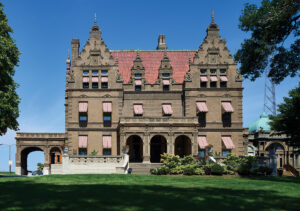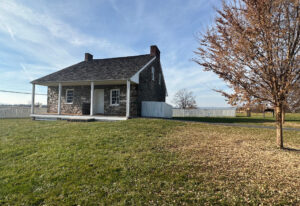Boston, known as The Cradle of Liberty, played a central role in the winning of American independence from Great Britain. Nothing shows this better than a leisurely afternoon walking tour of Boston’s historic Freedom Trail. This writer showed up on a warm afternoon at the Boston Common, a grassy park where 17th-century Bostonians would graze their cattle. There today a large group of history lovers (hailing from all over the United States, as well as a couple from Edinburgh, Scotland) was met by Revolutionary War hero Dr. Joseph Warren. He was dressed in black colonial breeches, white shirt and black vest, and wearing a tri-corner hat.
The good doctor (actor John Ferrara when he’s not giving historic tours) introduces himself and explains that he’d been friends with Paul Revere, and that he had helped defend Bunker Hill from the British on June 17, 1775. (The patriot actually died that day when he took a British musket ball during the enemy’s final charge.) Dr. Warren then takes us on the Freedom Trail, marked by a painted red line on the sidewalk, and explains the significance of each historic site along the way—no easy task amidst the din of passing Boston traffic.
First stop is Boston Common itself. We gather underneath a tree, and the noted physician-turned-revolutionary leader explains how the Puritans had arrived here in 1630 and used this grassy park as a “common” grazing ground for their livestock, and that it would remain open to livestock until 1830. He further describes how the Common was used for the public hanging of witches, heretics and criminals. Also, the city’s stockades were placed there, convenient for local Puritans to toss rotten vegetables at such miscreants as Sabbath breakers, blasphemers and gamblers. When the hated British army occupied Boston in the 1770s, notes Warren, they used the Common as a military camp.
We then walk to the golden-domed Massachusetts State House, built in the 1790s on land owned by patriot merchant John Hancock, who would become the state’s first elected governor. The classical building was designed by Bostonian Charles Bulfinch, who later designed the U.S. Capitol in Washington, Dr. Warren helpfully informs us.
He leads us to nearby Park Street Church, where abolitionist William Lloyd Garrison gave a passionate antislavery sermon on July 4, 1829. A white supremacist mob gathered outside the church, Warren tells us, then rushed inside and surrounded Garrison. They dragged the abolitionist from the pulpit and across the street to Boston Common, where they gave him a savage beating that left him nearly dead. The beating didn’t stop Garrison’s antislavery crusade: A few years later, he became the founding editor of The Liberator, the nation’s most famous abolitionist newspaper.
At the Granary Burial Ground, next to the church, three signers of the Declaration of Independence are buried, along with some 15,000 departed Bostonians. At the grave of John Hancock, Dr. Warren gives us the scoop on how much Hancock loathed George Washington. Indeed, chuckles our host, whenever Hancock and his wife quarreled (which was often), Mrs. Hancock was fond of telling her angry husband what a fine and attractive man General Washington was.
At Paul Revere’s gravesite, Dr. Warren remembers Revere’s legendary midnight ride, made famous in verse by poet William Wadsworth Longfellow. In fact, it was Doc Warren who dispatched Paul Revere and fellow patriot William Dawes to Lexington and Concord the night of April 18, 1775, after he had received intelligence about British troop movements. However, many of the details we learned in elementary school about Revere’s famous ride, the good doctor tells us, are more myth created by Longfellow than historically accurate.
Our host takes us to the gravesite of Samuel Adams, who Warren describes as one of the essential men behind the American Revolution. He notes that Adams, a brilliant propagandist, is buried next to the five victims of the Boston Massacre of 1770, an atrocity Adams used to discredit British colonial rule.
Dr. Warren speaks at length about the Boston Massacre, explaining that the British commander, Captain Preston, had ordered his surrounded men to “hold your fire!” But some of the nervous Redcoats, amidst all the confusion and confronted by an angry Boston mob, heard only the final word “fire!” and thus opened up on the unarmed Bostonians. The doctor reminds us that at the subsequent trial wherein some of the British were indicted, John Adams (Sam’s cousin) defended the Redcoats, and none of them ever went to prison for the killings (a second disgrace that cousin Sam Adams would use to build opposition to British colonial rule).
Down the street at the redbrick Old South Meeting House, our host sets the stage for a 1773 public meeting at which Sam Adams railed against the British-imposed tea tax. Adams called for defiance of the British, and arranged for his followers (the Sons of Liberty) to board British merchant ships and toss the tea into Boston Harbor. This Boston Tea Party so infuriated King George III that he ordered the port of Boston closed, escalating the crisis just as Adams had hoped he would. Dr. Warren offers that Sam Adams was a genius at provoking British colonial authorities to take rash actions that furthered the American cause of independence.
The final stop on our walking tour is Faneuil Hall, fronted by a statue of Sam Adams. Here, Bostonians met to protest British taxation and British rule, and cried out in favor of the concept, “no taxation without representation.” Decades later, abolitionists such as Garrison and Frederick Douglass would speak here about the evils of slavery. Dr. Warren, perhaps a bit wearied from so much walking and talking above Boston’s afternoon traffic, doffs his tricorner hat, bows gracefully to all of us and bids us “adieu.” We’ve traveled some 375 years in just over an hour, not a bad afternoon in Boston for a history lover.
Originally published in the October 2007 issue of American History. To subscribe, click here.




